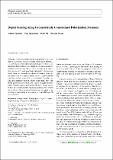| dc.contributor.author | Kadambi, Achuta | |
| dc.contributor.author | Taamazyan, Vage Aramaisovich | |
| dc.contributor.author | Shi, Boxin | |
| dc.contributor.author | Raskar, Ramesh | |
| dc.date.accessioned | 2018-06-18T18:00:53Z | |
| dc.date.available | 2018-06-18T18:00:53Z | |
| dc.date.issued | 2017-06 | |
| dc.date.submitted | 2016-05 | |
| dc.identifier.issn | 0920-5691 | |
| dc.identifier.issn | 1573-1405 | |
| dc.identifier.uri | http://hdl.handle.net/1721.1/116370 | |
| dc.description.abstract | Analyzing the polarimetric properties of reflected light is a potential source of shape information. However, it is well-known that polarimetric information contains fundamental shape ambiguities, leading to an underconstrained problem of recovering 3D geometry. To address this problem, we use additional geometric information, from coarse depth maps, to constrain the shape information from polarization cues. Our main contribution is a framework that combines surface normals from polarization (hereafter polarization normals) with an aligned depth map. The additional geometric constraints are used to mitigate physics-based artifacts, such as azimuthal ambiguity, refractive distortion and fronto-parallel signal degradation. We believe our work may have practical implications for optical engineering, demonstrating a new option for state-of-the-art 3D reconstruction. | en_US |
| dc.description.sponsorship | MIT Media Lab Consortium | en_US |
| dc.publisher | Springer-Verlag | en_US |
| dc.relation.isversionof | http://dx.doi.org/10.1007/s11263-017-1025-7 | en_US |
| dc.rights | Creative Commons Attribution-Noncommercial-Share Alike | en_US |
| dc.rights.uri | http://creativecommons.org/licenses/by-nc-sa/4.0/ | en_US |
| dc.source | Springer US | en_US |
| dc.title | Depth Sensing Using Geometrically Constrained Polarization Normals | en_US |
| dc.type | Article | en_US |
| dc.identifier.citation | Kadambi, Achuta, Vage Taamazyan, Boxin Shi, and Ramesh Raskar. “Depth Sensing Using Geometrically Constrained Polarization Normals.” International Journal of Computer Vision 125, no. 1–3 (June 22, 2017): 34–51. | en_US |
| dc.contributor.department | Massachusetts Institute of Technology. Media Laboratory | en_US |
| dc.contributor.department | Program in Media Arts and Sciences (Massachusetts Institute of Technology) | en_US |
| dc.contributor.mitauthor | Kadambi, Achuta | |
| dc.contributor.mitauthor | Taamazyan, Vage Aramaisovich | |
| dc.contributor.mitauthor | Shi, Boxin | |
| dc.contributor.mitauthor | Raskar, Ramesh | |
| dc.relation.journal | International Journal of Computer Vision | en_US |
| dc.eprint.version | Author's final manuscript | en_US |
| dc.type.uri | http://purl.org/eprint/type/JournalArticle | en_US |
| eprint.status | http://purl.org/eprint/status/PeerReviewed | en_US |
| dc.date.updated | 2017-11-19T05:28:12Z | |
| dc.language.rfc3066 | en | |
| dc.rights.holder | Springer Science+Business Media, LLC | |
| dspace.orderedauthors | Kadambi, Achuta; Taamazyan, Vage; Shi, Boxin; Raskar, Ramesh | en_US |
| dspace.embargo.terms | N | en |
| dc.identifier.orcid | https://orcid.org/0000-0002-2444-2503 | |
| dc.identifier.orcid | https://orcid.org/0000-0002-3254-3224 | |
| mit.license | OPEN_ACCESS_POLICY | en_US |
